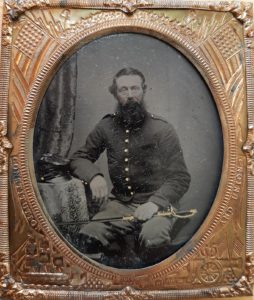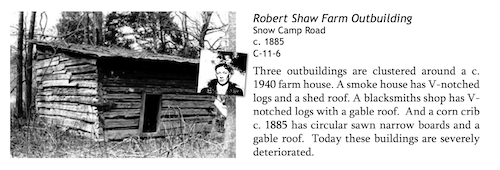Asher Waterman Harman
24 October 2021
This is a photograph of Asher W. Harman who was Colonel of the 12th Virginia Cavalry on the Maryland Campaign of 1862. It’s from descendent Li Harman who posted it to Asher’s Findagrave memorial.
Pre- and post- Conference snaps
24 October 2021
I had a tremendous time last weekend on and near the Antietam battlefield with my fellow Antietam Institute members at our first annual Fall Conference. Here we are at the New York State monument on Sunday morning.
For online coverage of that successful event, see the Institute’s Facebook page and those of other attendees.
I arrived in Sharpsburg on Thursday afternoon and had some time in the National Cemetery before dark. The sky was that particularly vivid shade of blue typical of the battlefield.
While there, I “collected” some Pennsylvania and Indiana gravestones to look into later. This one is for Private Erasmus Davenport of Company G, 27th Indiana Infantry.
Born in Brown County, Indiana on 3 September 1843, he enlisted at age 18 in September 1861. He died, probably of disease, in Frederick, Maryland less than three months later on New Year’s Day 1862. He was reinterred in the new National Cemetery about 1867.
I didn’t take many pictures during the Conference itself, but did grab this one on Saturday afternoon as the rain began.
It’s one of a pair of guns representing the position of Captain Hugh Garden’s Palmetto Artillery and is on the high ground of Cemetery Hill behind the National Cemetery. That battery was equipped with 2 12-pounder howitzers and 2 6-pounder guns. Neither type was rifled.
As some of the folks on the walk with me noted, it’s an interesting example. It’s apparently the tube of a Model 1841 6-pounder, but has been rifled. Perhaps in the James pattern? As I think of it now, a photo of the muzzle end would have been helpful.
After the final Conference hike on Sunday afternoon I fortified myself with a late lunch at the Battleview Market and returned to the Park for a last-chance visit before returning south for the winter. First stop, the West Woods and Philadelphia Brigade Park.
There are a few relatively recent monuments at Antietam – notably those for Texans (1964), Georgians (1961), and to the 11th Mississippi Infantry (2012, on then-private land) – planted during the Civil War Centennial and after. While I know the others well, this is one I hadn’t really noticed before.
It’s one of 3 placed by the state Centennial Commission in 1962 and 1964. The other two, to the First and Second Regiments, are in or near the Bloody Lane. Here’s a particularly interesting picture taken at the 1962 dedication of the one to the First Delaware.
I’d be interested to hear more about those uniforms!
Nearby, at the end of the road in the Philadelphia Brigade Park is an interpretive panel which I hope the Park can soon update or replace. It’s a little out of date. Here’s a detail from it:
It shows a house and barn on the battlefield across from the Cornfield, noting “This farm was not here in 1862.”
Known in modern times as the Wilson Farm, that land was part of the David R. Miller Farm at the time of the battle and there were no buildings on it then. In 2015 the Civil War (now Battlefield) Trust bought the 44 acre tract from the Wilson family. Later SHAF and the Trust had the buildings taken down and restored the landscape to its 1862 appearance. All of it is now Park property.
Finally, on the way out I stopped to spend a moment at my favorite battlefield farmstead: the Joseph Poffenberger place at the northern edge of the Park. Here’s it is just beyond a War Department marker locating part of the First Army Corps on the evening of 16 September 1862.
Until next time, so long, Antietam.
__________________
Notes
Click on any photo to see a larger version.
The itinerary of the 2021 Fall Conference is on the Institute’s website.
The group photograph of the Conference attendees above is by Randy Short for the Institute. The snapshots are my own.
Private Davenport’s details from his service record via fold3 and from family genealogists.
More about the representative cannons on the Antietam Battlefield in a WMIA/ Park brochure (still current and accurate?).
Thanks to Steve A. Hawks for his excellent Silent Sentinels monument database, linked here.
FYI. There has been a moratorium on new monuments on Park property at Antietam since 1991. Here’s a little background on that from some US Senate testimony in 2005 concerning a proposed new monument to New Hampshire troops (which was not placed):
A moratorium has been in place since 1991 at the [Antietam] battlefield, which precludes the construction of new monuments or memorials. The need for a moratorium was identified as necessary during the development of the General Management Plan (GMP). The GMP is a long-term planning document that provides NPS managers with guidelines and objectives in the preservation of these historic grounds. The study of the battlefield, which culminated in this GMP, was undertaken with substantial input from the public and civil war historians nationwide. The findings concluded that the continued addition of memorials would result in an unacceptable permanent alteration of the historic landscape. The NPS conducts an active year-round program to educate visitors about the Battle of Antietam and to pay tribute to the valor and sacrifice of all those who shared in the pivotal history of this battle …
That 1962 picture is from the Delaware Economic Development Photograph Collection, Delaware State Archives.
More photos of the old Wilson Farm are online from HistoryNet in a piece by Tom Clemens from 2017.
For fun, check out the Cultural Landscape of the J. Poffenberger farm today.
A.C.M. Pennington
4 October 2021
Lieutenant Alexander Cummings McWhorter Pennington commanded a section of Captain Tidball’s Battery A, 2nd US Artillery at Antietam in September 1862. This fine carte-de-visite of him is courtesy of Jim Rosebrock, from his collection.
Captain Rufus Washburn, 64th New York Infantry
20 September 2021
Captain Rufus Washburn was wounded in the shoulder in action at Antietam, probably in or near the infamous Bloody Lane, on 17 September 1862.
This magnificent hand-tinted photograph (in that fine case) is from great-great-grandson Pete Peterson.
Lt William West, 118th Pennsylvania Infantry
20 September 2021
Thanks to Jose A Franco for this excellent photograph of Lieutenant, later Captain, William West of the 118th Pennsylvania Infantry. He was with them at Shepherdstown/Boteler’s/Blackford’s Ford on 19 September 1862 and had a bullet rip open his coat in action there. He resigned his commission in January 1863 due to illness.
First Sergeant Samuel Little, 5th NH Infantry
11 September 2021
Thanks to Tom Rice for the pointer to this excellent photograph of Samuel Brown Little. The original is in the Lillenquist collection at the Library of Congress.
Sergeant Little was appointed 2nd Lieutenant of his Company in August 1862 and was wounded in the thigh at Antietam in September. He was mortally wounded at Fredericksburg and died nearby on Christmas Eve 1862.
Lieutenant Colonel James M Newton, 6th Georgia
14 July 2021
A well-to-do merchant from Butts County, James Mitchell Newton was appointed Lieutenant Colonel of the 6th Georgia Infantry at its organization in May 1861. He was mortally wounded in action at Sharpsburg on 17 September 1862 while in command of the remnants of the regiment in or near the Bloody Lane.
His portrait is thanks to descendants Mike Newton and Deidre Jean Hyde.
Battlefields revisited
2 April 2021
In an article in the National Tribune of 13 October 1892 [pdf] a veteran of the 45th Pennsylvania Infantry wrote to his comrades of his weekend visit to the battlefields on South Mountain and at Sharpsburg, MD 30 years after the combat there.
He mentioned Private Jacob Beirbower of Company B, who was severely injured in action above the Burnside Bridge at Antietam when “a grapeshot struck a top rail [of the fence he was behind], sent it flying through the air,” striking him on the right arm. Both lower arm bones were broken and he later lost the arm to amputation at the elbow.
Big thanks to Jim Smith [@CivilWarOnTour] for the pointer to Bierbower and that fine newspaper account, excerpted above.
Robert Shaw, Newlin, NC
30 March 2021
34 year old farmer Robert Shaw was conscripted into the Confederate Army at Raleigh in July 1862 and assigned to Company B of the First North Carolina Infantry. He was seriously wounded at Sharpsburg on 17 September 1862 and captured there. He returned to duty by January 1863, was captured again, at Spotsylvania Court House, VA in May 1864, and survived the prisons at Point Lookout, MD and Elmira, NY to return to his farm in Newlin, Alamance County, NC in June 1865.
He’s seen here in an undated post-war passport photograph contributed to his Findagrave memorial by user Roy K in December 2020. His smokehouse and much more about his community are found in the Alamance County Architectural Inventory (pdf, 2014) online from the County Historical Properties Commission.
USS Despatch (1873-1891)
8 March 2021
USS Despatch, the third US Navy ship of the name, was formerly the screw steamer America, purchased by the Navy in 1873.
She sailed 20 April 1877 for the eastern Mediterranean and a special assignment with the U.S. Embassy at Constantinople, Turkey. Arriving there 14 June, Despatch carried dispatches and transported the American minister to Turkey, in turmoil because of war with Russia and internal political unrest. She was detached early in 1879, and returned to her home port [of Washington, DC], where she was placed out of commission 9 July 1879.
Aboard for that cruise was a sailor named James Henry Bratton, late Private in the First North Carolina Infantry. James was wounded at Sharpsburg in September 1862 at age 17 but got through the rest of the war unharmed. Afterward he moved to Baltimore and was a marine fireman and engineer. He enlisted in the US Navy for four years in 1876, by then 31 years old.
Family lore says he told his wife he’d given four years to the Confederacy and four years to the United States (after his US Navy enlistment of 1876-1880). Maybe he figured that made him even.
The quote here from Despatch’s page in the Dictionary of American Naval Fighting Ships, online from the Naval History and Heritage Command. As is her photograph.



















